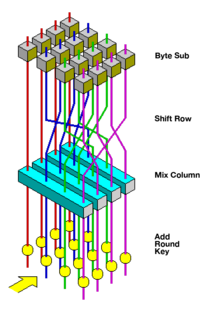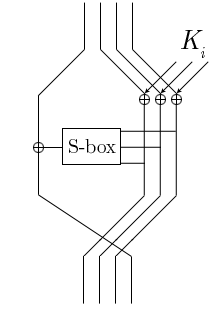Related Research Articles

The Advanced Encryption Standard (AES), also known by its original name Rijndael, is a specification for the encryption of electronic data established by the U.S. National Institute of Standards and Technology (NIST) in 2001.
In modern cryptography, symmetric key ciphers are generally divided into stream ciphers and block ciphers. Block ciphers operate on a fixed length string of bits. The length of this bit string is the block size. Both the input (plaintext) and output (ciphertext) are the same length; the output cannot be shorter than the input – this follows logically from the pigeonhole principle and the fact that the cipher must be reversible – and it is undesirable for the output to be longer than the input.
In cryptography, 3-Way is a block cipher designed in 1994 by Joan Daemen. It is closely related to BaseKing; the two are variants of the same general cipher technique.

Vincent Rijmen is a Belgian cryptographer and one of the two designers of the Rijndael, the Advanced Encryption Standard. Rijmen is also the co-designer of the WHIRLPOOL cryptographic hash function, and the block ciphers Anubis, KHAZAD, Square, NOEKEON and SHARK.
Joan Daemen is a Belgian cryptographer who co-designed with Vincent Rijmen the Rijndael cipher, which was selected as the Advanced Encryption Standard (AES) in 2001. More recently, he co-designed the Keccak cryptographic hash, which was selected as the new SHA-3 hash by NIST in October 2012. He has also designed or co-designed the MMB, Square, SHARK, NOEKEON, 3-Way, and BaseKing block ciphers. In 2017 he won the Levchin Prize for Real World Cryptography "for the development of AES and SHA3". He describes his development of encryption algorithms as creating the bricks which are needed to build the secure foundations online.

In cryptography, LOKI97 is a block cipher which was a candidate in the Advanced Encryption Standard competition. It is a member of the LOKI family of ciphers, with earlier instances being LOKI89 and LOKI91. LOKI97 was designed by Lawrie Brown, assisted by Jennifer Seberry and Josef Pieprzyk.
In cryptography, SHARK is a block cipher identified as one of the predecessors of Rijndael.
In cryptography, SAFER is the name of a family of block ciphers designed primarily by James Massey on behalf of Cylink Corporation. The early SAFER K and SAFER SK designs share the same encryption function, but differ in the number of rounds and the key schedule. More recent versions — SAFER+ and SAFER++ — were submitted as candidates to the AES process and the NESSIE project respectively. All of the algorithms in the SAFER family are unpatented and available for unrestricted use.

In cryptography, RC2 is a symmetric-key block cipher designed by Ron Rivest in 1987. "RC" stands for "Ron's Code" or "Rivest Cipher"; other ciphers designed by Rivest include RC4, RC5, and RC6.

In cryptography, DEAL is a symmetric block cipher derived from the Data Encryption Standard (DES). The design was proposed in a report by Lars Knudsen in 1998, and was submitted to the AES contest by Richard Outerbridge.

In cryptography, MacGuffin is a block cipher created in 1994 by Bruce Schneier and Matt Blaze at a Fast Software Encryption workshop. It was intended as a catalyst for analysis of a new cipher structure, known as Generalized Unbalanced Feistel Networks (GUFNs). The cryptanalysis proceeded very quickly, so quickly that the cipher was broken at the same workshop by Vincent Rijmen and Bart Preneel.

In cryptography, ICE is a symmetric-key block cipher published by Kwan in 1997. The algorithm is similar in structure to DES, but with the addition of a key-dependent bit permutation in the round function. The key-dependent bit permutation is implemented efficiently in software. The ICE algorithm is not subject to patents, and the source code has been placed into the public domain.
Akelarre is a block cipher proposed in 1996, combining the basic design of IDEA with ideas from RC5. It was shown to be susceptible to a ciphertext-only attack in 1997.
NOEKEON is a family of two block ciphers designed by Joan Daemen, Michaël Peeters, Gilles Van Assche and Vincent Rijmen and submitted to the NESSIE project in September 2000. The two ciphers are "direct mode" NOEKEON, to be used for maximum efficiency where related-key attacks are not possible, and "indirect mode" NOEKEON where they are.
Anubis is a block cipher designed by Vincent Rijmen and Paulo S. L. M. Barreto as an entrant in the NESSIE project, a former research program initiated by the European Commission in 2000 for the identification of new cryptographic algorithms. Although the cipher has not been included in the final NESSIE portfolio, its design is considered very strong, and no attacks have been found by 2004 after the project had been concluded. The cipher is not patented and has been released by the designers for free public use.
Panama is a cryptographic primitive which can be used both as a hash function and a stream cipher, but its hash function mode of operation has been broken and is not suitable for cryptographic use. Based on StepRightUp, it was designed by Joan Daemen and Craig Clapp and presented in the paper Fast Hashing and Stream Encryption with PANAMA on the Fast Software Encryption (FSE) conference 1998. The cipher has influenced several other designs, for example MUGI and SHA-3.
In cryptography, integral cryptanalysis is a cryptanalytic attack that is particularly applicable to block ciphers based on substitution–permutation networks. It was originally designed by Lars Knudsen as a dedicated attack against Square, so it is commonly known as the Square attack. It was also extended to a few other ciphers related to Square: CRYPTON, Rijndael, and SHARK. Stefan Lucks generalized the attack to what he called a saturation attack and used it to attack Twofish, which is not at all similar to Square, having a radically different Feistel network structure. Forms of integral cryptanalysis have since been applied to a variety of ciphers, including Hierocrypt, IDEA, Camellia, Skipjack, MISTY1, MISTY2, SAFER++, KHAZAD, and FOX.
In cryptography, DFC is a symmetric block cipher which was created in 1998 by a group of researchers from École Normale Supérieure, CNRS, and France Télécom and submitted to the AES competition.
In cryptography, truncated differential cryptanalysis is a generalization of differential cryptanalysis, an attack against block ciphers. Lars Knudsen developed the technique in 1994. Whereas ordinary differential cryptanalysis analyzes the full difference between two texts, the truncated variant considers differences that are only partially determined. That is, the attack makes predictions of only some of the bits instead of the full block. This technique has been applied to SAFER, IDEA, Skipjack, E2, Twofish, Camellia, CRYPTON, and even the stream cipher Salsa20.
The following outline is provided as an overview of and topical guide to cryptography:
References
- Joan Daemen; Lars Knudsen; Vincent Rijmen (1997). The Block Cipher Square. Fast Software Encryption (FSE) 1997, Volume 1267 of Lecture Notes in Computer Science. Haifa, Israel: Springer-Verlag. pp. 149–165. CiteSeerX 10.1.1.55.6109 .